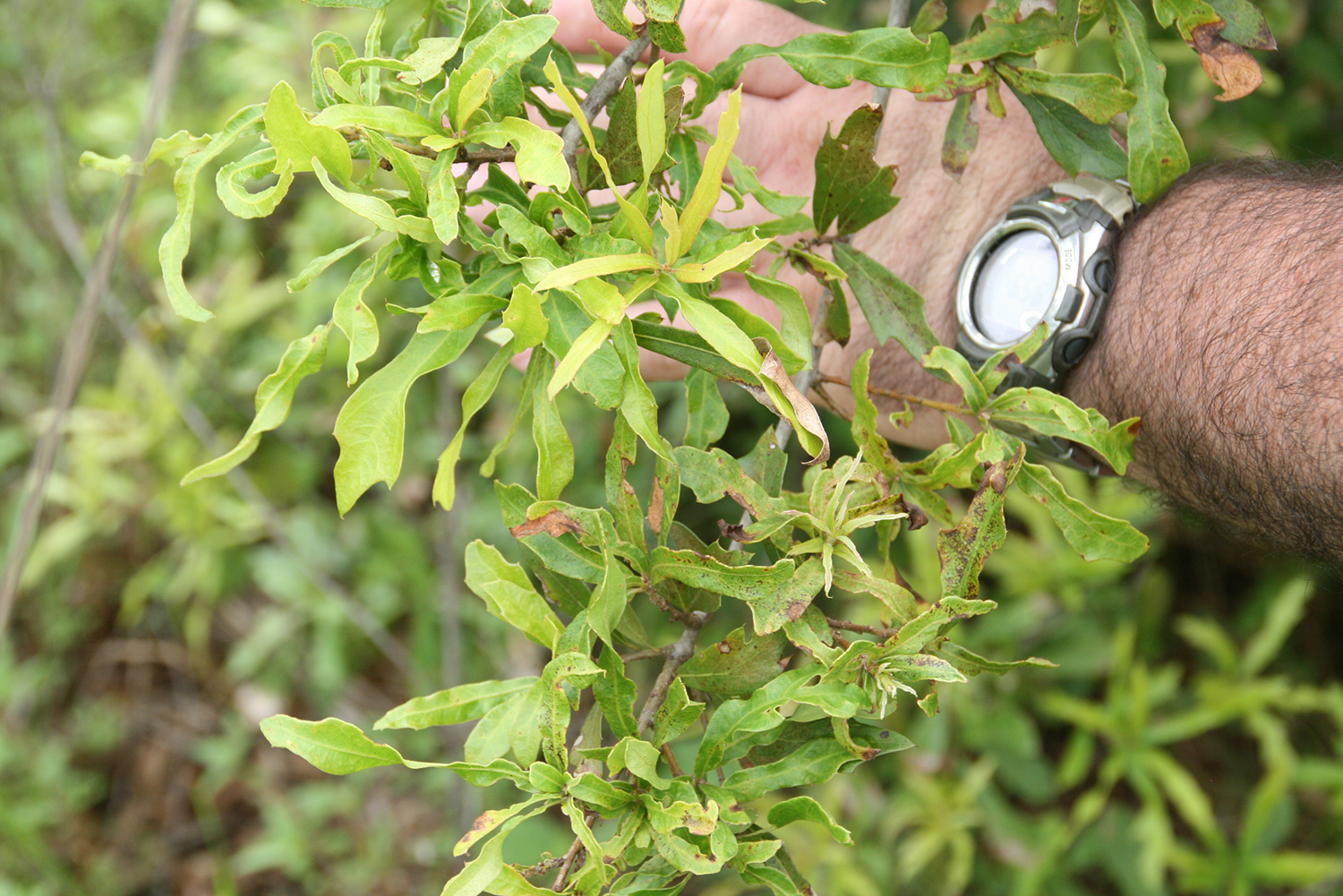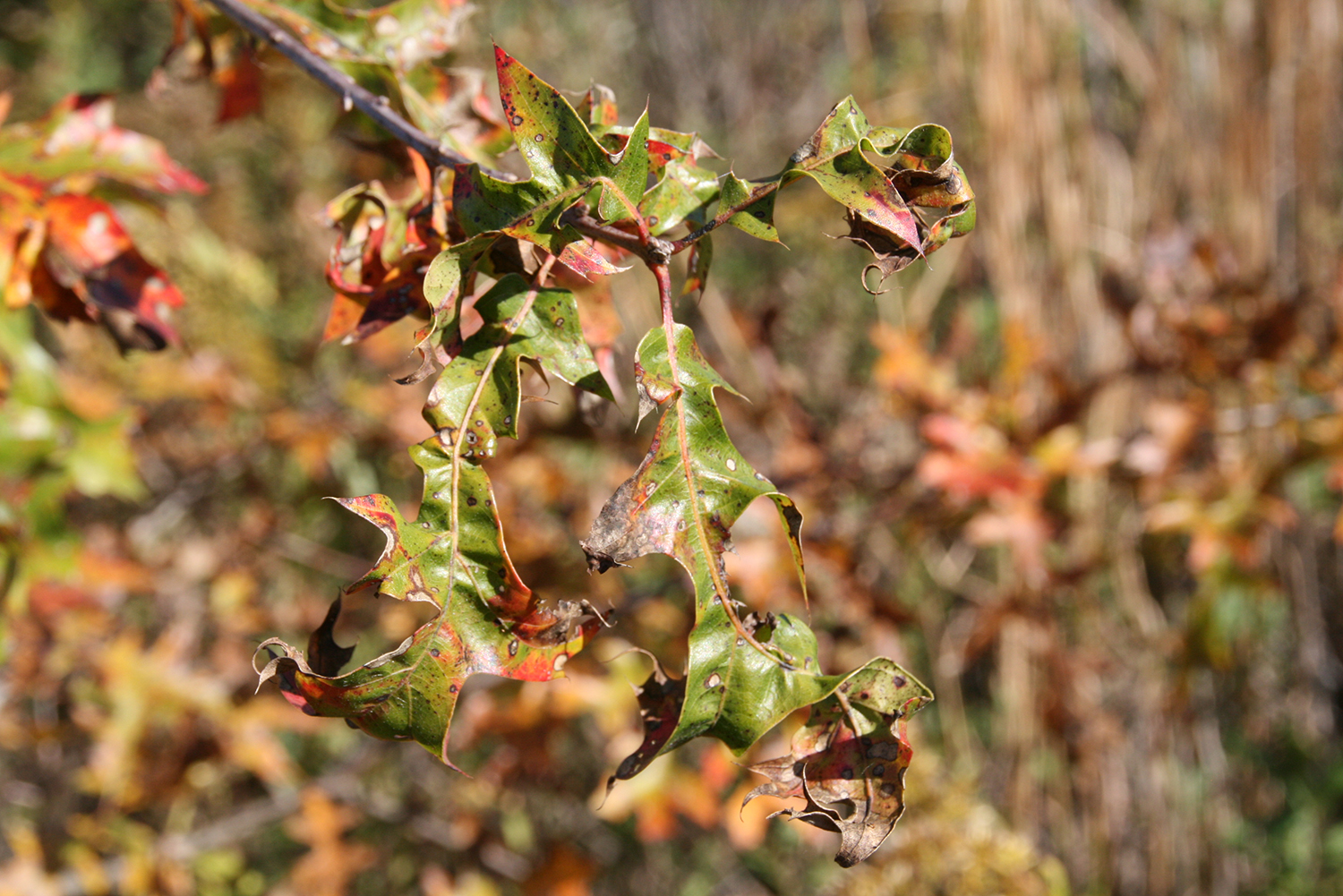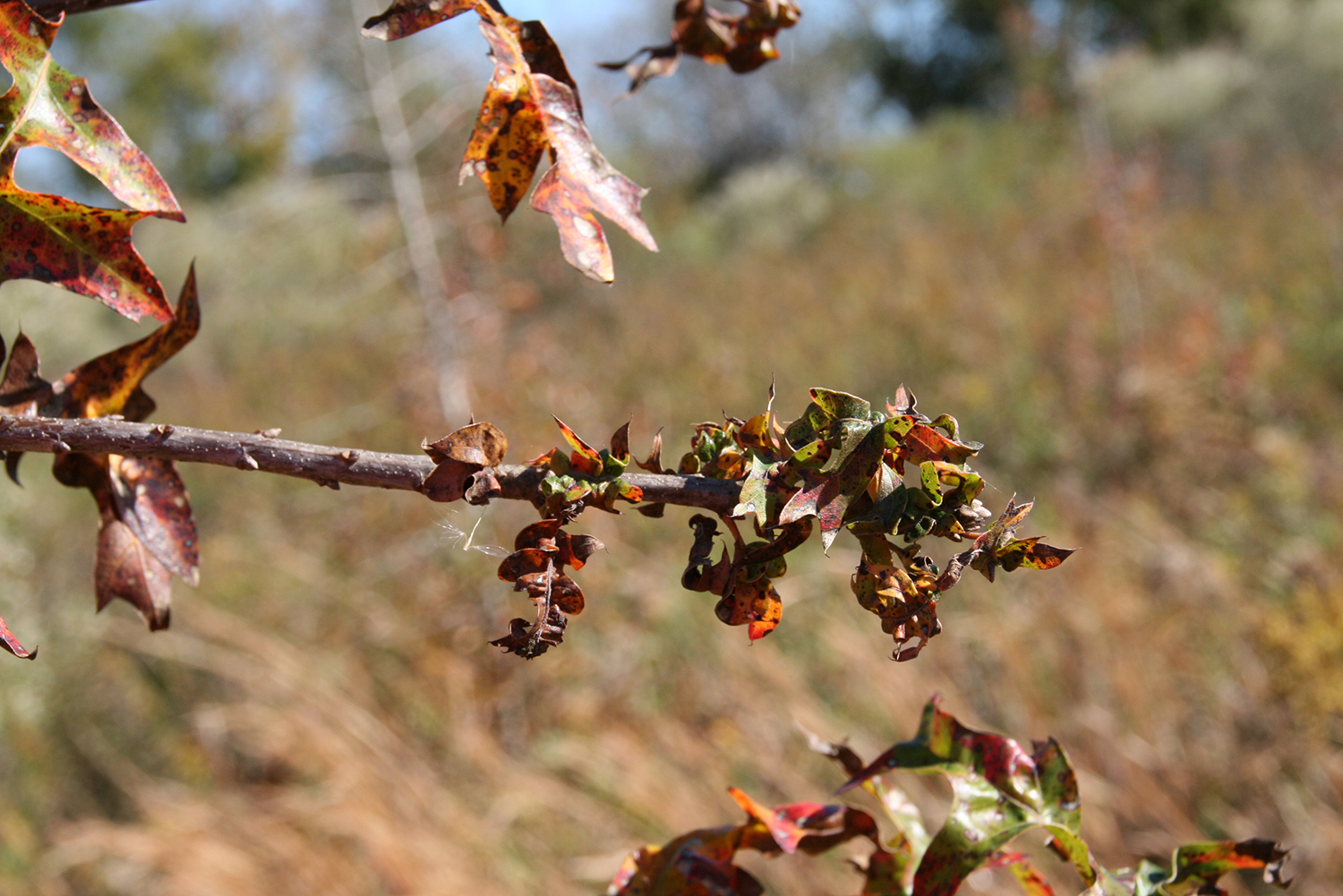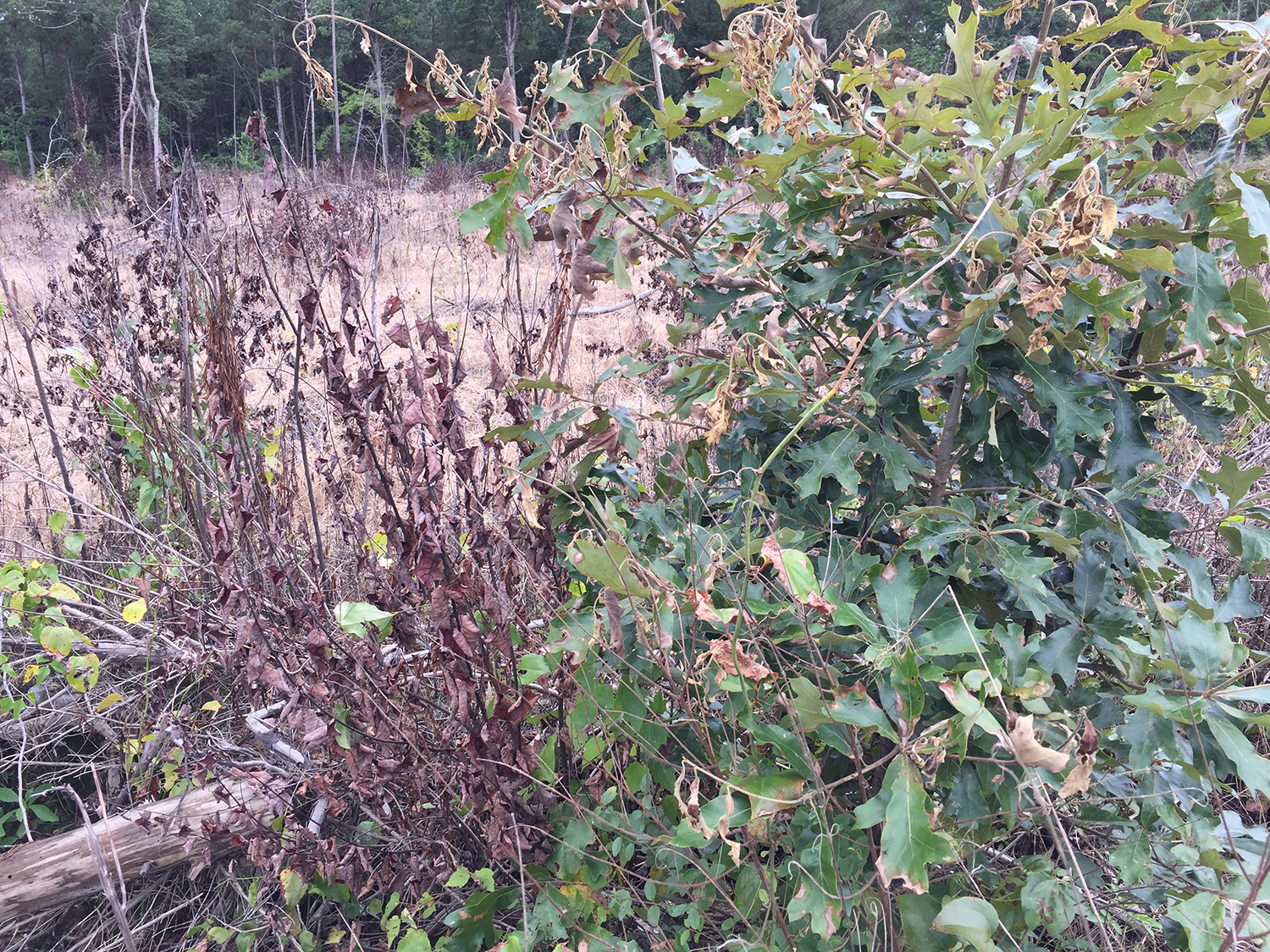Forest Environments: Identifying Herbicide Damage and Selecting Herbicides
Extension professionals receive questions regarding potential herbicide damage to trees and shrubs on a regular basis. While the person thought to be responsible for the damage, the herbicide used, and the specifics of the herbicide exposure are sometimes known, the questions frequently asked are, “What is killing my tree?” and “What can I do?” County Extension agents will often have the answers. They can assess damage and offer solutions to the landowner regarding damage mitigation and the probability of plant mortality.
However, there is some specific information that you can collect before contacting your local Extension agent that will help him or her quickly identify the problem and suggest corrective measures. If your agent needs to consult a specialist for assistance, this information will be very helpful.
Another frequent landowner request is for information on controlling a specific plant species under a variety of conditions. This is another subject that many Extension agents are familiar with, and they often can recommend specific herbicides to control unwanted vegetation. However, the matter can become more complicated when a target species is growing among desirable species you do not want to damage. In both scenarios, collecting specific information before contacting a professional can help facilitate quick and accurate solutions.
This publication will help you gather this needed information and outline ways to accurately document vegetation damage for natural resource professionals.
Digital Photography
Clear and well-focused, close-up photos are very helpful in identifying both species and damage symptoms. Remember, a picture is worth a thousand words. For more information on capturing quality photographs, please read MSU Extension Publication 3678 Taking Photos of Trees for Expert Identification and Urban Forest Inventories.
Herbicide Damage Identification
Nothing is more frustrating than suddenly discovering damage or death among your trees. There are many possible sources of damage, including fungal, bacterial, and viral organisms; animals (e.g., deer, birds, or rodents); insects; inclement weather conditions (e.g., drought, ice, or wind); and natural mortality. It can be tempting to assume one of these factors caused the damage that you are observing; however, do not discount the possibility of accidental herbicide exposure. This is especially true in areas near agricultural crops where herbicides are applied frequently. If a known misuse of herbicides occurred, damage is usually easy to assess and subsequent corrective action clear. However, the causal agent typically is not known, and many landowners turn to organizations like MSU Extension for help.
Collect the following information before contacting your Extension agent about potential herbicide damage to yard trees or shrubs. This information will help the agent quickly identify the problem and find a solution.
Application Specifics
You may not know the specific problem causing plant damage on your property. However, if you suspect herbicide misapplication, try to obtain any information you can regarding any herbicide applications that were performed near your property in the past several months. If you know or can obtain application details, make sure to record them. Pertinent information includes the date of nearby herbicide applications, products used, the type of application performed (e.g., agricultural burndown, forestry site preparation, or lawn maintenance), and the predominant way that herbicide was introduced to your property (e.g., direct spraying, runoff, or drift). Also note that under certain weather conditions, some herbicides may drift several miles. When drift occurs, similar damage may be observed between your property and the site of application.
Damage Details
Without properly documenting which herbicide symptoms are present, diagnosing your problem becomes much more time-consuming and less accurate. In addition, the delay may postpone corrective treatments long enough to make them useless. Several items should be observed and recorded.
- What does the damaged vegetation look like? Are the leaves curled and twisted? Are they dead, or do they have necrotic (dead) spots or portions? Are they yellowing or turning another non-green color? Note anything that seems out of the ordinary. This is where good photographs are necessary. Take photos as soon as possible after you first observe the damage. In addition, it may be important to record the progression of damage over time. Most herbicides do not kill trees instantly, and properly establishing which product was misapplied may require observing how damage progresses.
- What does adjacent vegetation look like? Many herbicides, especially those used in agriculture, are selective in nature. Some control grasses but do not impact broadleaf weeds or tree species. Some herbicides control broadleaf weeds but do not harm grass or woody species. For these reasons, it is very important that you investigate surrounding vegetation for signs of damage. This information may help eliminate various products from the list of herbicides that might have damaged your trees. Finally, some herbicides are selective within a vegetation category. For example, imazapyr (the active ingredient in the forestry herbicide Arsenal AC) is not harmful to pines at labeled rates. The same compound provides excellent control on many hardwood species. However, imazapyr does not control all hardwood species equally and typically does not result in substantial damage to leguminous (e.g., honeylocust, black locust, or redbud) or elm species. Noting herbicide symptoms on vegetation surrounding your damaged tree will help quickly identify what product might have caused the damage.




Selecting Herbicides
Another common question is, “What herbicide can I use to control (insert species name)?” The answer to this question is complicated and requires an understanding of herbicides, their effects on all plant species potentially impacted during an application, and the activity they may have in their surrounding environment. Several factors need to be considered when making any herbicide recommendation, and sometimes information on controlling specific species is lacking. As discussed above, the more information you can provide, the greater the likelihood of obtaining a quick and accurate prescription. In addition, providing a comprehensive list of site factors will greatly lower the chance of non-target herbicide impacts on surrounding vegetation.
Intended Target Vegetation
Obviously, the first thing that you need to determine is exactly what type of vegetation you are attempting to control. Some closely related plants react similarly to a given herbicide; others do not. If you are not sure of the exact species you wish to control, consult an Extension professional, forester, wildlife biologist, or other individual knowledgeable in the field of plant identification.
Once you have identified target vegetation, pay attention to what species are in the immediate vicinity. Some herbicides are foliar-active only (e.g., glyphosate) and will not damage plants unless their leaves are directly sprayed. Other herbicides are soil-active and are taken up through plant roots. Some herbicides have both types of activity. For this reason, unless you do not have any concerns regarding potential damage to surrounding vegetation, it is very important to note non-target plant species.

Environmental Factors
Even the best-researched herbicide recommendation may fail if certain environmental factors are not considered. Many will not affect herbicide prescriptions significantly; however, in some cases, not considering a given site’s environmental conditions can result in non-target vegetation impact, off-site movement of herbicides, or complete failure of the herbicide application. Understanding these interactions requires more than a passing knowledge of the subject. Your local Extension agent or specialist should be able to help you.
Some of these factors include, but are not limited to, soil texture, pH, presence of soil pans, ambient temperature, wind speed, and frequency and duration of flooding. Inherent soil-based factors can and will amplify or reduce herbicide efficacy in some circumstances. Acceptable temperature and wind speed are important factors when using herbicides. Use caution when applying herbicides in higher temperatures and winds. Ignoring these factors can result in non-target impact through volatilization and/or drift of your application. Depending on the herbicide selected, flooding can result in on- and off-site movement. (Herbicides may be moved off-site during flood events and result in damage to non-target plants, or they may pool on-site and create areas with too-low or too-high concentrations.) Note any other information you think is important regarding site conditions during your assessment, as well.
Timing
The time of year to apply herbicide depends on the target vegetation and the appropriate herbicide to treat it. Most herbicides have optimal application times. In addition, proper timing can vary depending on your target species. Some are more easily controlled at certain times of the year using specific herbicides.
Other Information
There are several non-biological factors to consider when using herbicides. One with legal consequences is herbicide application restrictions. For example, if you are attempting some form of vegetative control and your property is enrolled in some of the federal cost-share programs, proceed with caution. While some forms of herbicide use fall within the guidelines of these programs, others may not. Always consult the local administrator responsible for the particular program where your land is enrolled.
Conclusion
Always consider specific herbicide applications in light of the overall goals for your property, as well as liability issues. With any herbicide application, the ultimate question is, “If the risk of unwanted non-target impact is high, is treating the problematic vegetation worth the possibility of damage?” For example, is controlling that annoying thicket growing along your fence line really worth the risk and expense of accidentally destroying the adjacent rice field? A degree of common sense is required when applying herbicides.
Additional Reading
Gordon, Jason, and John Kushla. 2015. Taking Photos of Trees for Expert Identification and Urban Forest Inventories. Mississippi State University Extension IS2006. 2p.
Publication 3117 (POD-01-24)
By Brady Self, PhD, Associate Extension Professor, Forestry.
The Mississippi State University Extension Service is working to ensure all web content is accessible to all users. If you need assistance accessing any of our content, please email the webteam or call 662-325-2262.


